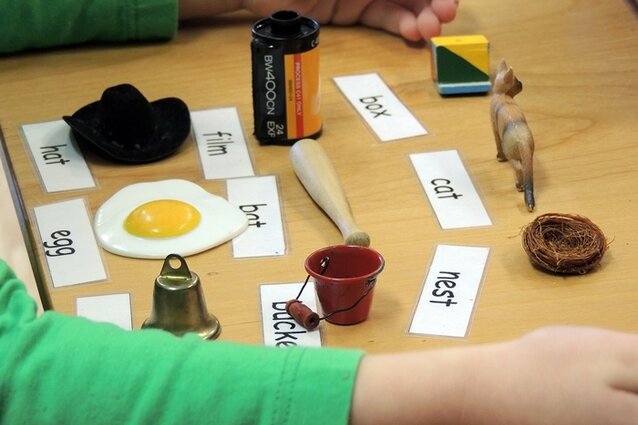
Work and Play
There was a great New Yorker cartoon several years ago showing a chaotic school of fish pointing every which way. Two fish are observing from afar, and one is remarking to the other, “I believe that’s a Montessori school.”
Another (mis)perception of Montessori is that the children are “forced to work” to the exclusion of creativity, self-expression—or in other words, of play.
So it would seem Montessori might have a bit of a PR issue with regard to “play” and “work”.
Thankfully, there is much attention these days on early-childhood learning and what best supports young children. All sorts of experts from a variety of social and scientific disciplines acknowledge how essential the first years of life are in the formation of the individual. The verdict is in: the direct link between the quality of a child’s early-childhood environment and experiences and their later academic, career, and life success/satisfaction is irrefutable. And the general consensus is that play-based learning provides the best outcomes.
If you Google preschool curricula, you’ll see two main categories crop up: “play-based learning” and “academic”, and from this separation one may well conclude that they are considered mutually exclusive. However, for the young child, there is no difference: play is their work. In the words of a very wise man, Fred Rogers, “Play is often talked about as if it were a relief from serious learning. But for children play is serious learning. Play is really the work of childhood.” Maria Montessori would have agreed – she wrote: “Play is the work of the child.”
Merriam-Webster defines play as “recreational activity; especially : the spontaneous activity of children”. Dr. Montessori observed that young children when given a choice were drawn more toward reality-based activities than traditional toys and would spontaneously choose these activities. This is why you won’t find toy flowers or plastic food in a Montessori classroom – instead, the children are given the opportunity to do the real-world activities the toys represent. All the materials in a Montessori environment are designed to spark imagination, creativity, and play. We don’t tell the children what story to write with the Moveable Alphabet, but we make sure they have a rich reservoir of real-life experiences from which to draw. The Number Rods or Puzzle Maps or Phonetic Object Box are every bit as fun, engaging, and conducive to open-ended exploration and play to the child as easel-painting is – it is our adult construct that academics are obligatory, drudgery, and something that must be got through so that we can have our fun doing something else.
What, then, is work? Our friends at Merriam-Webster define work as “something produced or accomplished by effort, exertion, or exercise of skill; something produced by the exercise of creative talent or expenditure of creative effort.” Montessori herself saw no difference in a young child’s “work” and “play” – they are one and the same. Montessori very intentionally used the term “work” to honor the child’s activity and to acknowledge the very profound physical, emotional, and psychological development taking place.
Adult work looks very different than a child’s work: we adults are geared toward productivity, visible results, and external goals, and we achieve these through division of labor, specialization, and the “law of least effort”. In fact, our society depends upon it—imagine if we all had to repair our own carburetors, or generate our own computer code, or grow all the food we eat. And while adult work can (and ideally should) be satisfying, all too often we consider it a four-letter word, something to be tackled, crossed off a list, or blitzed through so that we can get to what we really want to do, whatever that might be.
The young child’s work is nothing less than self-construction. Their work is inward, experiential, and without regard for external goals or outward results. As opposed to the adult aims of maximum efficiency and division of labor to get the job done as quickly and easily as possible, young children operate under the thrall of their own internal, unconscious developmental drivers. their activity engages all of their senses and is hands-on (according to Montessori, “The child gives us a beautiful lesson – that in order to form and maintain our intelligence, we must use our hands.”). Which is why the Montessori classroom is filled with beautiful, enticing materials and activities for the children to manipulate and use with their own powers of imagination and experimentation – for work and play.
Here are two great resources for further reading on young children and play:
Play and Children’s Learning, from the National Association for the Education of Young Children (NAEYC)
Play Learning and Montessori Education by Angeline Lillard, from The American Journal of Play
